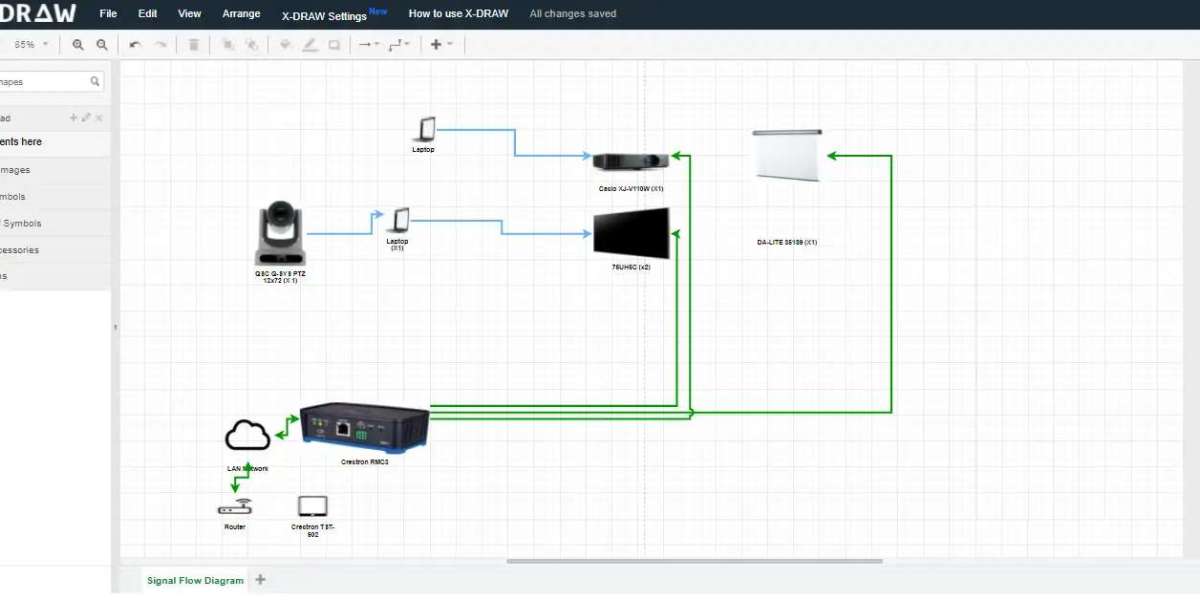In the world of electrical engineering, AV systems, and automation projects, diagrams play a crucial role in communicating designs effectively. Among the most common types are wiring diagrams and block diagrams. While both are used to represent circuits and systems, they serve different purposes and offer distinct levels of detail. Understanding their differences helps designers, technicians, and engineers choose the right tool for planning, documentation, and troubleshooting.
In this blog, we will explore wiring diagrams and block diagrams, explain their key differences, and show how tools like a wiring diagram maker or free wiring diagram software can simplify your design process.
1. What Is a Wiring Diagram
A wiring diagram is a detailed graphical representation of an electrical or AV system that shows the actual physical connections between components. It illustrates how wires, connectors, and devices are connected and how power or signals flow through the system.
Key characteristics of a wiring diagram include:
Detailed depiction of every wire and connection
Representation of switches, relays, outlets, lights, and other components
Use of standardized symbols to ensure clarity
Practical focus on installation, troubleshooting, and maintenance
Wiring diagrams are essential for technicians and installers because they show exactly how to wire a system. Using a wiring diagram maker or free wiring diagram software, designers can create clear, accurate diagrams that reduce errors during installation.
2. What Is a Block Diagram
A block diagram, on the other hand, provides a high level overview of a system rather than focusing on specific connections. It represents major components or functional units as simple blocks and shows how data, signals, or power flows between them.
Key characteristics of a block diagram include:
Simplified representation using blocks and arrows
Focus on system functionality rather than wiring details
Ideal for planning, concept design, and communication with non technical stakeholders
Helps visualize system interactions without getting bogged down by wiring specifics
Block diagrams are particularly useful in early stages of project planning or when explaining complex systems to clients, managers, or team members who do not need detailed installation instructions.
3. Level of Detail
One of the most significant differences between wiring diagrams and block diagrams is the level of detail they provide.
Wiring Diagrams: Highly detailed, showing every wire, connection point, terminal, and component. They are practical and actionable for building and troubleshooting circuits.
Block Diagrams: High level and conceptual, showing only functional units and connections between them. They do not include wiring specifics or component details.
For example, in an AV system, a wiring diagram would show every cable connecting speakers, microphones, amplifiers, and displays, while a block diagram would show blocks for the audio source, mixer, amplifier, and speakers with arrows indicating signal flow.
4. Purpose and Use Cases
The purpose of wiring diagrams and block diagrams also differs:
Wiring Diagrams: Used for installation, maintenance, and troubleshooting. Electricians, AV installers, and engineers rely on these diagrams to connect components accurately.
Block Diagrams: Used for system design, analysis, and presentations. Engineers, project managers, and clients use block diagrams to understand how a system functions without needing detailed wiring knowledge.
Choosing the right type of diagram depends on your audience and the stage of the project. Wiring diagrams are essential when physical implementation is involved, while block diagrams are ideal for planning and conceptual discussions.
5. Symbols and Representation
Wiring diagrams use standardized symbols to represent specific components like resistors, switches, batteries, and connectors. These symbols are universally recognized and ensure that anyone reading the diagram can understand it accurately.
Block diagrams, in contrast, use simple geometric shapes such as rectangles, circles, or ovals to represent functional units. Arrows indicate the flow of power, data, or signals between blocks, but component details are omitted.
Even when using a wiring diagram maker or free wiring diagram software, understanding the difference in symbol usage helps you choose the correct style for your project.
6. Complexity and Readability
Because wiring diagrams are highly detailed, they can become complex and difficult to read, especially for large systems. Proper organization, labeling, and layout are critical to maintaining clarity. Using software tools like a wiring diagram maker can automate layout, organize connections, and reduce clutter.
Block diagrams are simpler and more readable because they abstract away wiring details. They are designed to convey the overall system function quickly and clearly. This makes them ideal for presentations, reports, or initial design discussions.
7. Software Tools for Wiring Diagrams and Block Diagrams
Modern software makes creating both types of diagrams easier:
Wiring Diagram Maker: Tools like XTEN-AV allow you to create detailed wiring diagrams with drag and drop symbols, auto routing, and cloud collaboration. Free wiring diagram software is also available for simpler projects.
Diagramming Tools for Block Diagrams: Software like Lucidchart, Draw.io, or Microsoft Visio allows you to design block diagrams quickly. These tools provide customizable blocks, arrows, and templates for system representation.
Using the right software ensures accuracy, efficiency, and professional results whether you are designing wiring diagrams or block diagrams.
8. How They Complement Each Other
Wiring diagrams and block diagrams are not mutually exclusive. In fact, they often complement each other in the design process:
Start with a block diagram to plan the system structure and visualize functional relationships.
Once the design is finalized, create a wiring diagram to map out detailed connections and prepare for installation.
This approach ensures that both conceptual understanding and practical implementation are covered, reducing errors and improving workflow efficiency.
9. Tips for Using Wiring Diagram Makers and Free Wiring Diagram Software
To get the most out of your software tools:
Use libraries of prebuilt symbols to save time and maintain standards
Label all components and connections clearly
Organize diagrams using layers or sections for readability
Export diagrams in multiple formats such as PDF, PNG, or SVG for sharing
Regularly save and maintain version control to track changes
These practices help you produce professional and accurate diagrams every time.
Conclusion
Wiring diagrams and block diagrams serve different purposes but are both essential in electrical, AV, and automation projects. Wiring diagrams provide detailed, actionable instructions for installation and troubleshooting, while block diagrams offer a high level, conceptual view of system functionality.
Using tools like a wiring diagram maker or free wiring diagram software simplifies the creation of professional diagrams, whether detailed or conceptual. By understanding their differences, designers, engineers, and technicians can communicate more effectively, plan systems efficiently, and execute installations accurately.
Combining both types of diagrams in your workflow ensures clarity from concept to implementation, making projects more organized, efficient, and successful.
Read more: https://trendtracker.us/understanding-the-symbols-used-in-wiring-diagrams/














